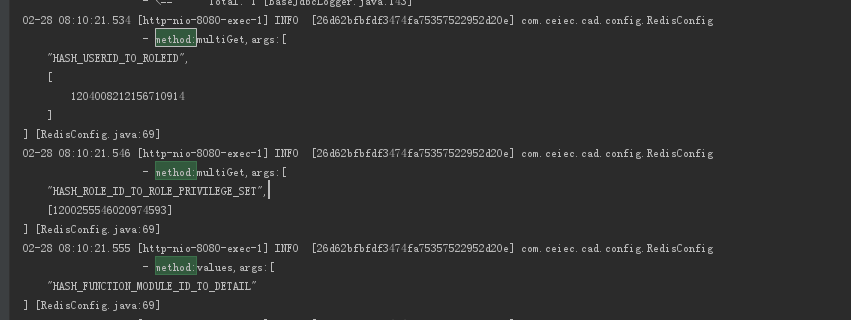曹工说Spring Boot源码(20)-- 码网恢恢,疏而不漏,如何记录Spring RedisTemplate每次操作日志
写在前面的话#
相关背景及资源:
曹工说Spring Boot源码(1)-- Bean Definition到底是什么,附spring思维导图分享
曹工说Spring Boot源码(2)-- Bean Definition到底是什么,咱们对着接口,逐个方法讲解
曹工说Spring Boot源码(3)-- 手动注册Bean Definition不比游戏好玩吗,我们来试一下
曹工说Spring Boot源码(4)-- 我是怎么自定义ApplicationContext,从json文件读取bean definition的?
曹工说Spring Boot源码(5)-- 怎么从properties文件读取bean
曹工说Spring Boot源码(6)-- Spring怎么从xml文件里解析bean的
曹工说Spring Boot源码(7)-- Spring解析xml文件,到底从中得到了什么(上)
曹工说Spring Boot源码(8)-- Spring解析xml文件,到底从中得到了什么(util命名空间)
曹工说Spring Boot源码(9)-- Spring解析xml文件,到底从中得到了什么(context命名空间上)
曹工说Spring Boot源码(10)-- Spring解析xml文件,到底从中得到了什么(context:annotation-config 解析)
曹工说Spring Boot源码(11)-- context:component-scan,你真的会用吗(这次来说说它的奇技淫巧)
曹工说Spring Boot源码(12)-- Spring解析xml文件,到底从中得到了什么(context:component-scan完整解析)
曹工说Spring Boot源码(13)-- AspectJ的运行时织入(Load-Time-Weaving),基本内容是讲清楚了(附源码)
曹工说Spring Boot源码(14)-- AspectJ的Load-Time-Weaving的两种实现方式细细讲解,以及怎么和Spring Instrumentation集成
曹工说Spring Boot源码(15)-- Spring从xml文件里到底得到了什么(context:load-time-weaver 完整解析)
曹工说Spring Boot源码(16)-- Spring从xml文件里到底得到了什么(aop:config完整解析【上】)
曹工说Spring Boot源码(17)-- Spring从xml文件里到底得到了什么(aop:config完整解析【中】)
曹工说Spring Boot源码(18)-- Spring AOP源码分析三部曲,终于快讲完了 (aop:config完整解析【下】)
曹工说Spring Boot源码(19)-- Spring 带给我们的工具利器,创建代理不用愁(ProxyFactory)
工程结构图:
概要#
本篇是独立的,和前面几篇aop相关分析没有特别关联,但是使用了上一篇提到的工具类。
曹工说Spring Boot源码(19)-- Spring 带给我们的工具利器,创建代理不用愁(ProxyFactory)
之前也使用类似的思路,实现过完整sql日志记录。
曹工杂谈--使用mybatis的同学,进来看看怎么在日志打印完整sql吧,在数据库可执行那种
这两天在搬砖,有个需求,是统计类的。一般来说,统计类的东西,比如要统计:用户总数,用户的新增总数,当天每个小时为维度的新增数量,各个渠道的新增用户数量;这些,可能都得在redis里维护,然后某个用户注册时,去把所有这些redis结构+1。
但这种代码,一般入口很多,修改这些值的地方很多,编码时很容易发生遗漏,或者编码错误,导致最后统计数据不准确。数据不准确,当然是bug,问题是,这种bug还不好排查。
如果能够记录下redis操作日志就好了。
以下,是我已经实现的效果,这是一次请求中的一次redis操作,可以看到,是put方法。
实现思路#
我们用的是spring boot 2.1.7,直接集成的RedisTemplate。当然,只要是使用RedisTemplate即可,和spring boot没多大关系。
我看了下我们平时是怎么去操作redis 的hash结构的,大概代码如下:
@Autowired
@Qualifier("redisTemplate")
private RedisTemplate<String,Object> redisTemplate;
HashOperations<String, HK, HV> ops = redisTemplate.opsForHash();
ops.put(key, hashKey,fieldValue);
一般就是,先通过opsForHash,拿到HashOperations,再去操作hash结构。
我现在的想法就是,在执行类似ops的put的方法之前,把那几个参数记录到日志里。
要想让ops记录我们的日志,我们只能拦截其每个方法,这一步就得使用一个代理对象,去替换掉真实的对象。
但是,怎么才能让redisTemplate.opsForHash()返回的ops,是我们代理过的对象呢?
所以,这一步,还得在生成redisTemplate的地方下功夫,让其生成一个redisTemplate的代理对象,这个代理对象,拦截opsForHash方法。
总结下,需要做两件事:
- 对redisTemplate做代理,拦截opsForHash方法;
- 在拿到第一步的原有的ops对象后,对ops对象做代理,拦截其put方法等。
代码实现#
原有代码#
@Configuration
public class RedisConfig {
@Bean
public RedisTemplate<String,Object> redisTemplate(RedisConnectionFactory redisConnectionFactory) {
RedisTemplate<String,Object> template = new RedisTemplate<>();
template.setValueSerializer(new CustomGenericJackson2JsonRedisSerializer());
template.setHashKeySerializer(new CustomHashKeyRedisSerializer());
template.setKeySerializer(RedisSerializer.string());
template.setHashValueSerializer(new CustomGenericJackson2JsonRedisSerializer());
template.setConnectionFactory(redisConnectionFactory);
return template;
}
代理RedisTemplate#
@Bean
public RedisTemplate<String,Object> redisTemplate(RedisConnectionFactory redisConnectionFactory) {
RedisTemplate<String,Object> template = new RedisTemplate<>();
template.setValueSerializer(new CustomGenericJackson2JsonRedisSerializer());
template.setHashKeySerializer(new CustomHashKeyRedisSerializer());
template.setKeySerializer(RedisSerializer.string());
template.setHashValueSerializer(new CustomGenericJackson2JsonRedisSerializer());
template.setConnectionFactory(redisConnectionFactory);
ProxyFactory proxyFactory = new ProxyFactory();
proxyFactory.setTarget(template);
proxyFactory.setProxyTargetClass(true);
proxyFactory.addAdvice(new MethodInterceptor() {
@Override
public Object invoke(MethodInvocation invocation) throws Throwable {
//拦截opsForHash
boolean b = invocation.getMethod().getName().equals("opsForHash");
if (b) {
// todo,下一步再完善这里
}
return invocation.proceed();
}
});
//这里获取到针对template的代理对象,并返回
Object proxy = proxyFactory.getProxy();
return (RedisTemplate<String, Object>) proxy;
}
大家可以仔细看上面的代码,利用了前一讲我们学习了的ProxyFactory,来生成代理;使用它呢,比较方便,不用管底层它是用jdk动态代理,还是cglib代理,spring已经帮我们处理好了。
总之,上面这段,就是把redisTemplate给换了。我们具体要在拦截了opsForHash里,做什么动作呢?我们再看。
代理opsForHash的返回结果#
@Bean
public RedisTemplate<String,Object> redisTemplate(RedisConnectionFactory redisConnectionFactory) {
RedisTemplate<String,Object> template = new RedisTemplate<>();
template.setValueSerializer(new CustomGenericJackson2JsonRedisSerializer());
template.setHashKeySerializer(new CustomHashKeyRedisSerializer());
template.setKeySerializer(RedisSerializer.string());
template.setHashValueSerializer(new CustomGenericJackson2JsonRedisSerializer());
template.setConnectionFactory(redisConnectionFactory);
ProxyFactory proxyFactory = new ProxyFactory();
proxyFactory.setTarget(template);
proxyFactory.setProxyTargetClass(true);
proxyFactory.addAdvice(new MethodInterceptor() {
@Override
public Object invoke(MethodInvocation invocation) throws Throwable {
boolean b = invocation.getMethod().getName().equals("opsForHash");
if (b) {
// 1. 这一步,拿到原有的opsForHash的返回结果
HashOperations hashOperations = (HashOperations) invocation.proceed();
//2. 下边,对hashOperations进行代理
ProxyFactory proxyFactory = new ProxyFactory();
proxyFactory.setTarget(hashOperations);
proxyFactory.setProxyTargetClass(false);
proxyFactory.setInterfaces(HashOperations.class);
//3. 我们这个代理干什么事呢,就是加了一个方法前的拦截器,记录日志
proxyFactory.addAdvice(new MethodBeforeAdviceInterceptor(new MethodBeforeAdvice() {
// 使用fastjson格式化了参数,并记录到日志
@Override
public void before(Method method, Object[] args, Object target) {
log.info("method:{},args:{}",method.getName(),
JSON.toJSONString(args, SerializerFeature.PrettyFormat));
}
}));
// 这里返回针对hashOperations的代理
return proxyFactory.getProxy();
}
return invocation.proceed();
}
});
Object proxy = proxyFactory.getProxy();
return (RedisTemplate<String, Object>) proxy;
}
总结#
我这个拦截比较粗,现在是把get类的日志也打出来了。大家可以判断下method的名称,来自行过滤掉。
ok,本篇先到这里。下讲继续讲Spring ProxyFactory的内容。







【推荐】国内首个AI IDE,深度理解中文开发场景,立即下载体验Trae
【推荐】编程新体验,更懂你的AI,立即体验豆包MarsCode编程助手
【推荐】抖音旗下AI助手豆包,你的智能百科全书,全免费不限次数
【推荐】轻量又高性能的 SSH 工具 IShell:AI 加持,快人一步
· go语言实现终端里的倒计时
· 如何编写易于单元测试的代码
· 10年+ .NET Coder 心语,封装的思维:从隐藏、稳定开始理解其本质意义
· .NET Core 中如何实现缓存的预热?
· 从 HTTP 原因短语缺失研究 HTTP/2 和 HTTP/3 的设计差异
· 周边上新:园子的第一款马克杯温暖上架
· 分享 3 个 .NET 开源的文件压缩处理库,助力快速实现文件压缩解压功能!
· Ollama——大语言模型本地部署的极速利器
· DeepSeek如何颠覆传统软件测试?测试工程师会被淘汰吗?
· 使用C#创建一个MCP客户端
2017-02-28 centos7搭建nexus maven私服